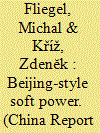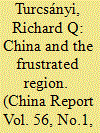|
|
|
Sort Order |
|
|
|
Items / Page
|
|
|
|
|
|
|
| Srl | Item |
| 1 |
ID:
170655


|
|
|
|
|
| Summary/Abstract |
This article examines China’s unique soft power conceptualisation, which differs from the American coinage. It contributes to the existing literature by demonstrating how soft power is theorised by Chinese academicians and policymakers in a distinct way. That means, according to China’s own tradition, predating the term. Unlike in America, where soft power is largely developed freely, in China, it is highly centralised. As a rising power, the People’s Republic initially concentrates on building domestic soft power, primarily through socialist culture and virtuous governance. These are in turn displayed to the outside world. Beijing uses multiple channels to tell the China story and has been setting up international platforms to portray itself as a responsible global actor. Several soft power indexes show that China holds a relatively positive image in Africa and South America. In Asia, views are mixed, while in Europe and North America, they remain low.
|
|
|
|
|
|
|
|
|
|
|
|
|
|
|
|
| 2 |
ID:
170658


|
|
|
|
|
| Summary/Abstract |
Central and Eastern Europe (CEE) had few historical opportunities to interact with China, but with the Belt and Road Initiative (BRI) and the 16+1 platform, that changed dramatically in recent years. The article discusses recent development in the China-CEE relations with the aim of explaining why the CEE countries became excited about China initially, but also why this excitement led prevailingly to disappointment. It will be argued that the frustration with the EU in the aftermath of the 2008 crisis created an environment in which China was, for a moment, perceived as a promising alternative. A few years into the new diplomatic initiatives, however, most of the CEE countries started to be unsatisfied with the lack of economic results. Eventually, the article will assess the implications of the new era of China-CEE relations for the EU affairs and broader Chinese relations with the developing world. The CEE region is in a specific position vis-à-vis China, for it is structurally in between the developed and the developing world. Moreover, the EU membership adds some critical features which make the Chinese offer less applicable and appealing.
|
|
|
|
|
|
|
|
|
|
|
|
|
|
|
|
| 3 |
ID:
170659


|
|
|
|
|
| Summary/Abstract |
China–Qatar ties have strengthened considerably in recent years. The relationship between the two countries has seen steady and smooth bilateral development in the political, economic and cultural fields; in trade, energy and other areas and has given active play to the complementarities between the two economies. This study wants to examine the motivation behind Beijing’s measures to formalise a strategic partnership with Qatar to understand the impact and the extent of the Qatar-Gulf crisis on Doha engagement and integration within the Belt and Road Initiative. China’s measures to formalise strategic partnerships with Qatar includes seven major areas for cooperation: policy coordination, connectivity, trade and investments, energy cooperation, financial cooperation, military ties, tourism and cultural ties.
|
|
|
|
|
|
|
|
|
|
|
|
|
|
|
|
| 4 |
ID:
170657


|
|
|
|
|
| Summary/Abstract |
The South China Sea disputes involve both island and maritime claims among several sovereign states within the region, namely China, Malaysia, the Philippines, Brunei, Vietnam and Taiwan. Framing an analysis of international news and diplomatic relations allows researchers to examine how news organisations provide their audiences with context regarding news stories through content promotion and exclusion. This study examined how the Malaysian and Chinese newspapers reported about the South China Sea disputes and Malaysia–China bilateral relations. The findings indicated that the newspapers reported the topics with different intensity and prominence, while different news sources were employed. It was also found that conflict was a salient frame used by the various newspapers. In addition, this study found that the Malaysian and Chinese newspapers exhibited different valence in reporting the South China Sea disputes. Among the Malaysian newspapers under examination in this study, Sin Chew Daily (a Chinese-language daily) employed the most similar frame to that of the Chinese newspapers, where the coverage was pervasive with supportive valence towards China.
|
|
|
|
|
|
|
|
|
|
|
|
|
|
|
|
| 5 |
ID:
170656


|
|
|
|
|
| Summary/Abstract |
Since 2015, the strong resentment in Chinese social media against international immigration triggered by the European migrant crisis has been noticed, and in many cases harshly criticised, by foreign media. Using primary sources retrieved from a major microblogging site, this article provides a critical review of the way in which the crisis was represented in popular discourse between 2015 and 2017and explores the intricate sentiments it provoked. It employs the analytical framework of critical discourse analysis developed by Fairclough to illustrate how multi-dimensional discourse construction shaped the perceptions in social media. It argues that the mostly sensationalist narratives, created through recontextualisation of long-standing nationalist discourses, reflect the dilemma between China’s ambitious globalist vision for future development and the persistent myth of homogeneity of Chinese nationhood. As China undergoes a slow and reluctant transition from a traditional source of emigration to a budding destination for international immigrants, such a dilemma has broader implications for the Chinese perceptions of the European Other and China’s self-positioning in the world.
|
|
|
|
|
|
|
|
|
|
|
|
|
|
|
|
| 6 |
ID:
170660


|
|
|
|
|
| Summary/Abstract |
Southeast Asia with its historical concentration of ethnic Chinese remains an important economic hub encouraging cross-disciplinary inquiries on themes relating to businesses. In industrialising Malaysia, there is little research on their capacity to develop tacit knowledge of the founding generation mostly inherited from China, before starting a business in Malaysia. This assessment of four thriving Malaysian Chinese family SMEs in food production evaluates how a new generational change has innovated their traditional food products. Interestingly, tradition may enable these Malaysian Chinese firms to innovate by building on more reliable knowledge and resources, extensively validated over time, and hence reduce development and utilisation costs. The well-trained second and third generations have been innovating tacit knowledge to elicit strong and positive feelings of ‘Chinese’ identity, increasing the value of new products through R&D by embedding past knowledge and facilitating the legitimacy of innovative functionalities and obtaining market acceptance.
|
|
|
|
|
|
|
|
|
|
|
|
|
|
|
|
|
|
|
|
|